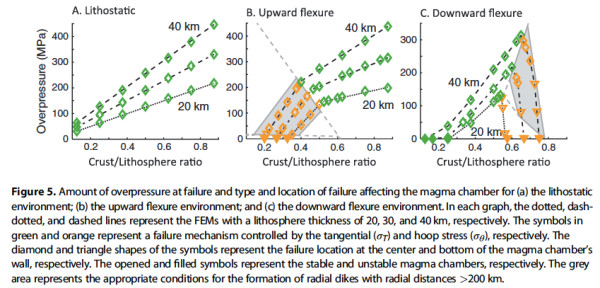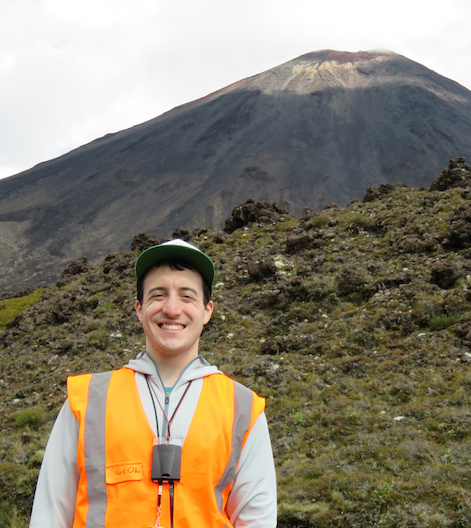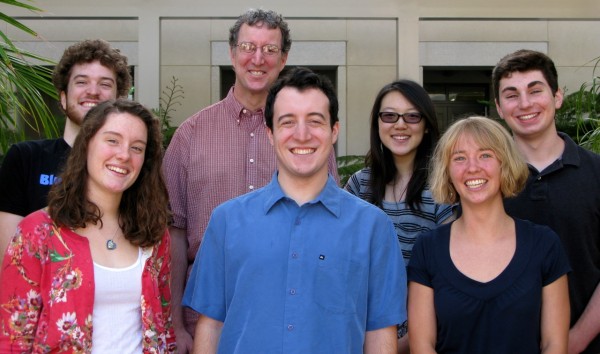As described in a previous post, giant radial dike systems may be commonly observed on Earth and Venus but that doesn’t mean they’re easy to form! In a paper recently published in the Journal of Geophysical Research-Planets, Dr. Nicolas Le Corvec, Dr. Gerald Galgana, Dr. Patrick McGovern (colleagues from the Lunar and Planetary Institute in Houston, TX) and I show that mechanical layering — i.e. including crust and mantle layers explicitly within a modeled lithosphere — can help promote radial dike formation and long-distance propagation. Specifically, when a mechanically layered lithosphere flexes due to either surface or basal loading (e.g., in response to edifice growth or plume impingement), radial dikes formed by rupture of an inflating magma reservoir can in some circumstances propagate for 100’s of kilometers. In addition to providing new mechanical insight into giant radial dike swarm formation, our results are also important because the lateral extent of giant radial dike systems can, in theory, provide a new way to constrain the ratio of crust and mantle lithospheric layer thicknesses on Venus.
For more information: Le Corvec, N., P.J. McGovern, E.B. Grosfils, and G. Galgana, 2015. Effects of crustal-scale mechanical layering on magma chamber failure and magma propagation within the Venusian lithosphere. Journal of Geophysical Research-Planets, 120, doi:10.1002/2015JE004814.

Posted in Publication, Research | Comments (0)

Robby commences his Fulbright by mapping volcanic units at Ngauruhoe volcano, New Zealand
Robby Goldman (PO ’15), who spent his summer and senior year using finite element models to explore caldera formation, was recently chosen to receive a Fulbright Award that enables him to spend 2016 in New Zealand continuing his research under the guidance of Darren Gravley (’96). In 2017 Robby will expand his skills as a graduate student working with Trish Gregg at the University of Illinois Urbana-Champaign. My heartiest congratulations Robby!
More information:
Posted in Research, Students | Comments (0)

— Student research team, Summer 2014
In March volcanology research results, obtained by six students working with Prof. Grosfils during the previous summer, were presented at the 2015 Lunar and Planetary Science Conference in Houston, TX. Work performed by Robby Goldman (’15) and Jack Albright (’16) was shared via “Ring Fault and Caldera Formation: Insights Provided by Three-Dimensional Elastic Finite Element Models,” while Erin Barry (’17), Annika Deurlington (’16), Amanda Yin (’17) and Michael Wucher (’17) helped advance our understanding of subsurface magmatism via the presentation “Using Map-Derived Hoop Strain and Elastic Models of Reservoir Formation to Quantify the Degree of Dike Emplacement at Giant Radial Lineament Systems on Venus.” Our tradition of celebrating student achievement and performance at the conference continued, with attending students joining other Sagehen alumni at the conference for some conversation and reminiscing over refreshments: while planetary geology is a specialized field to be sure, it is a lot of fun to see the cadre of Sagehen enthusiasts involved growing steadily over time!
Posted in Uncategorized | Comments (0)
In December of 2014 I attended my second IAVCEI sponsored conference focused on collapse calderas. Happily, the conference took place in and around Lake Taupo within the Taupo Volcanic Zone on the north island of New Zealand, site of one of the youngest known “supereruptions” on Earth. With two days of conference presentations and discussion, bracketed by field days spent exploring the Taupo and Rotorua calderas and other local volcanics, the conference was a great opportunity to continue advancing our understanding of the chemical signatures, mechanical processes and field deposits that characterize large caldera formation.

— Rotorua Caldera
After the conference I treated myself to a Lord of the Rings day, albeit one that continued to explore a strongly volcanic theme! Driving north from Taupo I first visited the Hobbiton movie set, located within scenic ignimbrite deposits.

— hobbit holes

— Hobbiton’s view of the Green Dragon inn
After enjoying Hobbiton I drove south past Lake Taupo to have a quick look at Mt. Doom (Ngauruhoe) and two adjacent volcanoes (Ruapehu, Tongariro) within Tongariro National Park. I didn’t have enough time for a tramp, but will look forward to that on my next visit!

— Lovely but dangerous Mt. Ruapehu
With conferences in Bolsena, Italy and now in Taupo, New Zealand setting a high standard, I look forward very much to the next IAVCEI caldera conference, which will be held in Hokkaido, Japan in the Fall of 2016!
Posted in Research | Comments (0)






